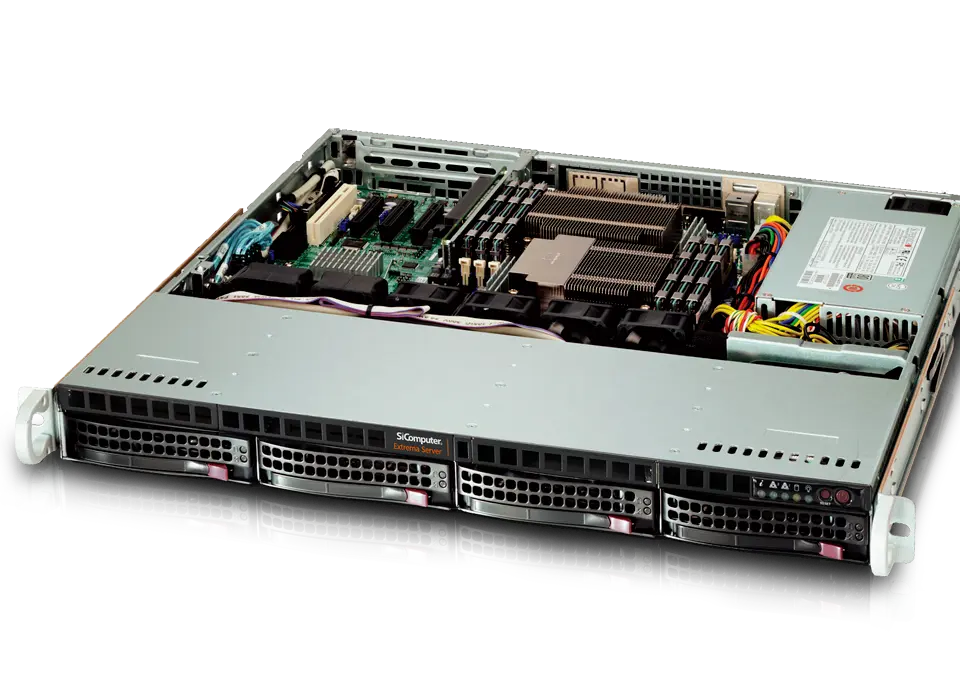Table of Contents
- Understanding 1U Servers
- Benefits of 1U Servers
- Common Uses of 1U Servers
- How to Choose the Right 1U Server
- Setting Up and Configuring 1U Servers
- Maintenance and Troubleshooting
- Case Studies and Real-world Applications
- Future Trends in Server Technology
Understanding 1U Servers
Rack servers that use just one unit of vertical space in a typical 19-inch server rack are known as one-unit (1U) servers. These compact and efficient solutions are commonly used in data centers to maximize space without compromising performance. The size of a mini 1U server typically measures about 1.75 inches in height, making it an ultra-compact option that still packs a strong punch in terms of processing power and storage capacity.
Understanding the specific functionalities of a mini 1U server can help IT managers and business owners make informed decisions about their data infrastructure. Typically, these servers are equipped with high-performance CPUs such as AMD EPYC or Intel Xeon, plenty of RAM (up to 256GB), and several storage choices, such as SSDs and HDDs. Such configurations allow 1U servers to handle multiple applications, from simple file storage to computational-intensive tasks like data analytics and virtual machine hosting.
Benefits of 1U Servers
- Space-saving design: A 1U server’s small size is one of its key advantages. This allows more servers to be installed in a single rack, maximizing the physical space in a data center. Efficient space utilization is crucial, especially in urban areas where real estate is costly. Higher rack density also means less expenditure on facilities like air conditioning and housing costs, leading to overall savings.
- Cost-effective: 1U servers are an excellent option for startups because of their smaller size and reduced power consumption, which makes them typically more affordable for small to medium-sized firms. The initial capital investment for these servers is lower compared to larger units. Additionally, reduced energy consumption translates into lower operating costs over the server’s lifecycle, providing an economically viable solution for growing businesses.
- Energy efficiency: 1U servers are designed to consume less power, significantly reducing operational costs and contributing to a more sustainable data center environment. These servers often have energy-efficient components and advanced cooling systems that lower electricity use. This lessens carbon emissions and supports international initiatives for environmental responsibility and sustainability.
- Scalability: These servers offer scalable solutions that can grow with your business. They can be easily upgraded with additional storage or memory as needed. Companies can start with a minimal setup and expand their infrastructure gradually, which is particularly beneficial for technology firms and other fast-paced industries. This flexibility ensures that companies do not invest heavily upfront, thus managing their resources more efficiently.
Common Uses of 1U Servers
1U servers are versatile and find applications in a variety of settings. They are trendy for:
- Web hosting: These servers can host multiple websites and applications, providing reliable service to users. Given their efficiency, 1U servers are often employed by hosting providers to serve numerous clients from a single physical machine. This setup enhances resource utilization and offers a consolidated platform for web-based services.
- File storage: They can efficiently store and manage vast amounts of data. Businesses dealing with substantial data, such as media companies or research institutions, find 1U servers highly effective for their storage needs. Advanced RAID (Redundant Array of Independent Disks) setups improve data security and access speed.
- Running applications: With powerful processors and ample memory, 1U servers can handle demanding applications and workloads. This includes mission-critical programs like customer relationship management (CRM) software and corporate resource planning (ERP) systems, which require reliable and robust server performance.
Many growing businesses and startups prefer 1U servers due to their efficient performance and scalability. These servers are ideal for dynamic and evolving operational needs, enabling companies to adapt quickly to changing market demands and technological advancements.
How to Choose the Right 1U Server
When choosing a 1U server, consider your business requirements and future growth plans. Assess workload requirements by selecting a model that meets these demands, such as high processing power and extensive memory capacity for big data analytics or standard configurations for primary file storage or web hosting. Evaluate hardware specifications by considering processor speed, memory capacity, and storage options. Modern 1U servers offer a range of hardware choices to cater to different performance levels, ensuring optimal performance and cost efficiency. Consider future growth by opting for a server with scalability options, such as hot-swappable drives, multiple expansion slots, and easy access to internal components. This foresight can save costs and downtime as operational requirements evolve.
Setting Up and Configuring 1U Servers
Setting up a 1U server involves several steps. First, install the server in a rack and connect it to your network. Next, configure the server settings to optimize performance and security. This may include setting up RAID for data redundancy, adjusting BIOS settings, and installing necessary software. Effective configuration is crucial for ensuring the server operates efficiently and securely.
- Installation: Physically install the server into the rack and connect the necessary cables. This includes securing the server with mounting brackets and ensuring all power and network connections are firmly in place.
- Network Configuration: Configure the server to connect to your network, ensuring it has the desired IP addresses and access settings. Proper network setup is essential to avoid conflicts and ensure seamless communication with other network devices.
- Performance Optimization: Tweak settings to ensure the server operates at peak efficiency, including adjusting cooling options and power settings for energy savings. Performance optimization also involves load balancing and virtualization to maximize resource utilization.
Maintenance and Troubleshooting
Regular maintenance and proactive troubleshooting are vital to keep your 1U servers running smoothly. This includes monitoring system performance, updating firmware, and addressing issues promptly to avoid downtime. TechRadar says maintaining your servers is crucial for avoiding downtime and ensuring reliability. Routine checks, such as inspecting hardware components, verifying software updates, and monitoring logs for anomalies, are essential practices.
Future Trends in Server Technology
The landscape of server technology is continually evolving, with several exciting trends shaping the future of 1U servers. Technology breakthroughs and shifting business requirements are the main drivers of these changes. Some of the noteworthy trends include:
- AI integration: Incorporating artificial intelligence to enhance server management and optimize performance. AI-powered systems can monitor server health in real time, predict potential failures, and automatically balance workloads, improving efficiency and reducing downtime.
- Enhanced security features: Advanced security protocols to protect data and prevent unauthorized access. With the growing number of cyber threats, integrating robust security measures like encryption, multi-factor authentication, and real-time threat detection is vital for safeguarding sensitive information.
- Greater energy efficiency: New technologies aim to reduce power consumption while maintaining high performance. Innovations like liquid cooling, energy-efficient chipsets, and intelligent power management can significantly lower operating costs and support eco-friendly initiatives.
Developing emerging trends will enhance the creation of powerful, efficient, and secure data center environments, revolutionizing business IT infrastructure management and ensuring organizations can leverage these advancements for a competitive edge.







